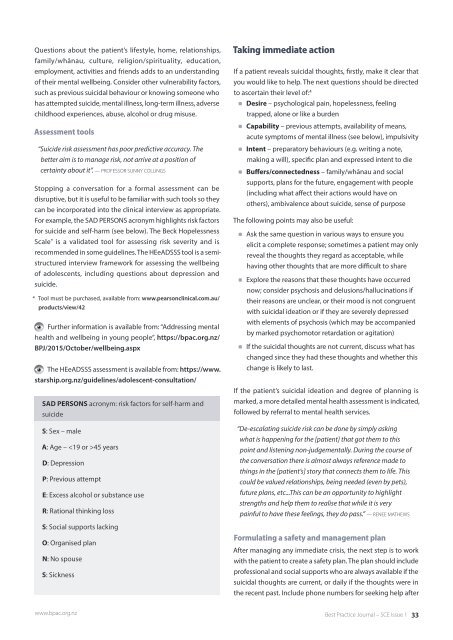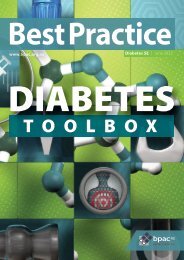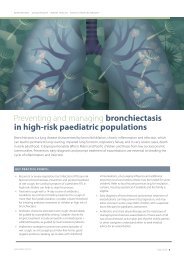Create successful ePaper yourself
Turn your PDF publications into a flip-book with our unique Google optimized e-Paper software.
Questions about the patient’s lifestyle, home, relationships,<br />
family/whānau, culture, religion/spirituality, education,<br />
employment, activities and friends adds to an understanding<br />
of their mental wellbeing. Consider other vulnerability factors,<br />
such as previous suicidal behaviour or knowing someone who<br />
has attempted suicide, mental illness, long-term illness, adverse<br />
childhood experiences, abuse, alcohol or drug misuse.<br />
Assessment tools<br />
“Suicide risk assessment has poor predictive accuracy. The<br />
better aim is to manage risk, not arrive at a position of<br />
certainty about it”. — PROFESSOR SUNNY COLLINGS<br />
Stopping a conversation for a formal assessment can be<br />
disruptive, but it is useful to be familiar with such tools so they<br />
can be incorporated into the clinical interview as appropriate.<br />
For example, the SAD PERSONS acronym highlights risk factors<br />
for suicide and self-harm (see below). The Beck Hopelessness<br />
Scale * is a validated tool for assessing risk severity and is<br />
recommended in some guidelines. The HEeADSSS tool is a semistructured<br />
interview framework for assessing the wellbeing<br />
of adole<strong>sce</strong>nts, including questions about depression and<br />
suicide.<br />
* Tool must be purchased, available from: www.pearsonclinical.com.au/<br />
products/view/42<br />
Further information is available from: “Addressing mental<br />
health and wellbeing in young people”, https://bpac.org.nz/<br />
BPJ/2015/October/wellbeing.aspx<br />
The HEeADSSS assessment is available from: https://www.<br />
starship.org.nz/guidelines/adole<strong>sce</strong>nt-consultation/<br />
SAD PERSONS acronym: risk factors for self-harm and<br />
suicide<br />
S: Sex – male<br />
A: Age – 45 years<br />
D: Depression<br />
P: Previous attempt<br />
E: Excess alcohol or substance use<br />
R: Rational thinking loss<br />
S: Social supports lacking<br />
O: Organised plan<br />
N: No spouse<br />
S: Sickness<br />
Taking immediate action<br />
If a patient reveals suicidal thoughts, firstly, make it clear that<br />
you would like to help. The next questions should be directed<br />
to a<strong>sce</strong>rtain their level of: 4<br />
Desire – psychological pain, hopelessness, feeling<br />
trapped, alone or like a burden<br />
Capability – previous attempts, availability of means,<br />
acute symptoms of mental illness (see below), impulsivity<br />
Intent – preparatory behaviours (e.g. writing a note,<br />
making a will), specific plan and expressed intent to die<br />
Buffers/connectedness – family/whānau and social<br />
supports, plans for the future, engagement with people<br />
(including what affect their actions would have on<br />
others), ambivalence about suicide, sense of purpose<br />
The following points may also be useful:<br />
Ask the same question in various ways to ensure you<br />
elicit a complete response; sometimes a patient may only<br />
reveal the thoughts they regard as acceptable, while<br />
having other thoughts that are more difficult to share<br />
Explore the reasons that these thoughts have occurred<br />
now; consider psychosis and delusions/hallucinations if<br />
their reasons are unclear, or their mood is not congruent<br />
with suicidal ideation or if they are severely depressed<br />
with elements of psychosis (which may be accompanied<br />
by marked psychomotor retardation or agitation)<br />
If the suicidal thoughts are not current, discuss what has<br />
changed since they had these thoughts and whether this<br />
change is likely to last.<br />
If the patient’s suicidal ideation and degree of planning is<br />
marked, a more detailed mental health assessment is indicated,<br />
followed by referral to mental health services.<br />
“De-escalating suicide risk can be done by simply asking<br />
what is happening for the [patient] that got them to this<br />
point and listening non-judgementally. During the course of<br />
the conversation there is almost always reference made to<br />
things in the [patient’s] story that connects them to life. This<br />
could be valued relationships, being needed (even by pets),<br />
future plans, etc...This can be an opportunity to highlight<br />
strengths and help them to realise that while it is very<br />
painful to have these feelings, they do pass.” — RENEE MATHEWS<br />
Formulating a safety and management plan<br />
After managing any immediate crisis, the next step is to work<br />
with the patient to create a safety plan. The plan should include<br />
professional and social supports who are always available if the<br />
suicidal thoughts are current, or daily if the thoughts were in<br />
the recent past. Include phone numbers for seeking help after<br />
www.bpac.org.nz<br />
Best Practice Journal – SCE Issue 1 33









